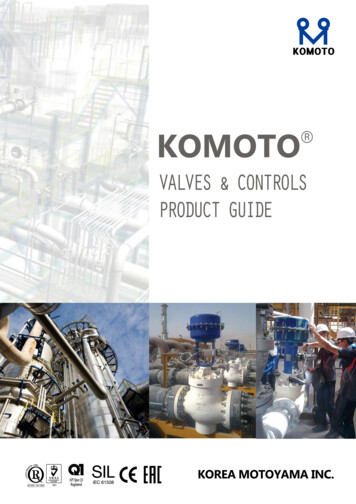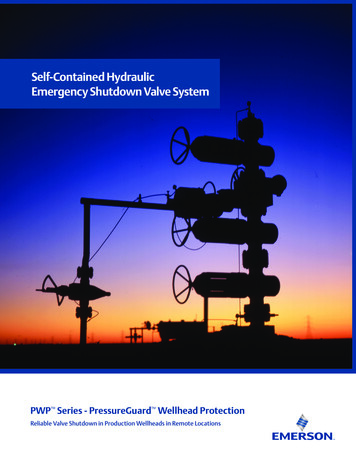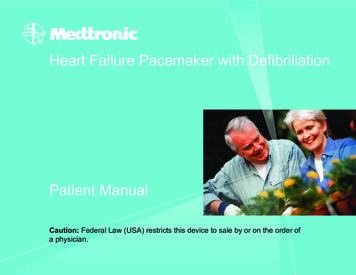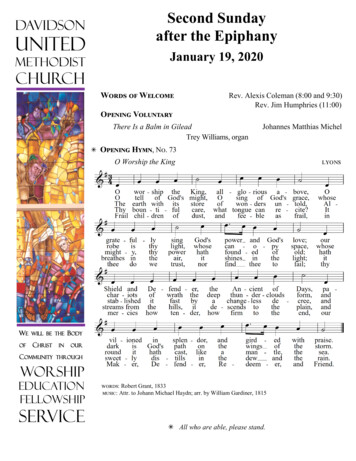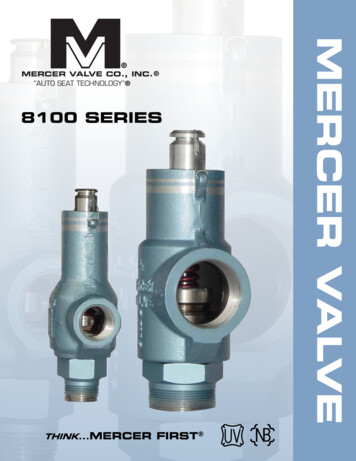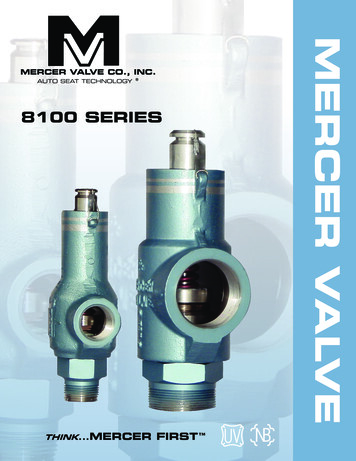
Transcription
1
Featured SpeakersDr. Charles DavidsonProfessor of Medicine, Division of Cardiology,Northwestern MedicineChicago, Illinois(312) 926-8948Learn More.Dr. Chris MalaisrieProfessor of Surgery, Division of Cardiac Surgery,Northwestern MedicineChicago, Illinois(888) 535-6197Learn More.Adam PickPatient, Author & Website FounderHeartValveSurgery.comLos Angeles, California(888) 725-43112
Table of ContentsIntroduction4Human Heart Anatomy8Aortic Stenosis Causes & Symptoms10Aortic Disease Indications & Treatment12SAVR & TAVR Overview14Surgical Aortic Valve Replacement16The Ross Procedure17TAVR Development & History18TAVR Approaches20TAVR Advantages & Risks23TAVR Clinical Trial Update25TAVR Valve-in-Valve Procedures31SAVR Mechanical Valve Clinical Trial Update32TAVR Experience at Northwestern Medicine33TAVR vs SAVR Procedure Distribution34TAVR Procedures By Operative Risk35Questions & Answers36Patient Resources503
IntroductionAdam Pick: Hi, everybody. My name is Adam Pick, and if I have yet to meetyou, I’m the patient who started HeartValveSurgery.com all the way back in2006. Today,we have a very special webinar which is SAVR, surgical aortic valvereplacement, versus TAVR, transcatheter aortic valve replacement: What ShouldPatients Know?Our mission at HeartValveSurgery.com is to educate and empower patients. Thiswebinar, which has had registrations from 550 patients is designed to supportthat mission.We have a great agenda for today’s webinar. I’m going to introduce the featuredspeakers. We’re going to talk about aortic valve disease, have a meaningfulconversation about SAVR and TAVR, answer your questions, and then as wewrap up the webinar, I’m going to ask you to complete a very quick five-questionsurvey to help us enhance these community events in the future.4
Now for the introductions.I would submit to you that we have on the line with us today really a dynamicduo or aortic valve replacement. We have Dr. Charles Davidson on the line who’sthe Professor of Medicine, Clinical Chief, Division of Cardiology, at NorthwesternUniversity Feinberg School of Medicine. He’s also the Medical Director at BluhmCardiovascular Institute at Northwestern Memorial Hospital in Chicago.One thing I know about Dr. Davidson is that he is one of the leaders whenit comes to clinical trial research. I know of his work on the PARTNER trial,EVOQUE, EARLY TAVR, PASCAL, REPAIR MR and many more. He is a consultant toand he receives grant support from Edward Lifesciences and Abbott.5
We also have another, really big member of the heart team, which is Dr. ChrisMalaisrie who is a Professor of Surgery at the Division of Cardiac Surgery atNorthwestern University Feinberg School of Medicine. He’s the program directorof thoracic surgery residence and fellowship at Bluhm Cardiovascular Instituteand Northwestern Memorial Hospital.As you may have seen over the years in all of his education videos, Dr. Malaisriespecializes in minimally invasive and very complex valve surgery including valvesparing aortic root replacement and the Ross Procedure. Like Dr. Davidson, Dr.Malaisrie is a clinical trial specialist and right now he’s working on several trialsincluding PARTNER 3 Valve-in-Valve, the Medtronic Apollo Trial, and the CryolifePROACT Xa Trial that has gotten a lot of attention recently. He is a consultant toand receives grant support from Edwards Lifesciences.6
In addition to all of these incredible credentials for both Dr. Davidson and Dr.Malaisrie, what I know after seeing these two physicians in the operating roomsat Northwestern and seeing them in the cath lab and seeing them in the hybridoperating suite, I know what really drives these two men. It’s not the credentials.Instead, it’s the success and the health of their patients. Over the years that wehave partnered with Northwestern Medicine, several hundred patients havefound their way to Northwestern and had extraordinary results.Whether it’s Paul Powers, Jesse McBride, Jean Frank, Janis Kielbasa, Jim Whitney,the list goes on and on. With that, I can do nothing but thank Dr. Davidson andDr. Malaisrie for all their past work with patients and all the future work they’regoing to be doing to help folks just like you and me. With that said, I’m going toturn this webinar over to Dr. Charles Davidson and Dr. Chris Malaisrie.7
Human Heart AnatomyDr. Davidson: It’s really a pleasure to be on the webinar and to be able tospeak about transcatheter aortic valve replacement, which has had really atransformation in the last couple years. When we were putting together thistalk, Dr. Malaisrie and I, it’s amazing how much it’s changed in just a short periodof time. First of all, it’s been an absolute honor, privilege, and just a ton of funworking with Dr. Malaisrie over the years. I think we’ve been at this for 15 yearstogether. Dr. Malaisrie remarked the other day I think I know your next movebefore you make it. I said I think the same thing with you.It’s really the type of partnership that we’ve developed that’s led to what wewake up for in the morning, which is getting great patient outcomes. Hopefullythe clinical trials help move that forward, and that’s what we’re going to try topresent with you today is what’s going on today with transcatheter aortic valvereplacement.8
For those that want an anatomy of the human heart, how does it all occur, youlook at how blood gets into the heart. It gets in from the superior vena cava andinferior vena cava, the big veins in the body, to the right atrium, goes throughthe tricuspid valve, goes through the right ventricle, goes out to the lungs, getsits oxygen, comes back to the left atrium, then goes through the mitral valve andthen what we call the main pumping chamber of the heart, the left ventricle, andthen out through the aortic valve.Today we’re going to focus on that aortic valve because it can both block up,what we call stenosis, or it can cause leaking, which we call aortic regurgitation.It’s the final exit point of the heart and the blood to the rest of the body.9
Aortic Stenosis Causes & SymptomsDr. Davidson: As I gave you the information of how blood gets through theheart, aortic stenosis is generally calcified blockage of the valve. There areother causes of blocking up the aortic valve, but far and away it’s calcific aorticstenosis. This is not something that occurs because of bad diet or not a lack ofexercise or even other factors that we might think about with coronary arterydisease, high cholesterol. Those aren’t clearly related to this. Sometimes, veryfrequently in younger patients, it’s due to a valve that was not properly formedfrom the day they were born called bicuspid aortic valve disease.Also, tricuspid aortic valve stenosis, which means it has three leaflets that cometogether but have now developed calcium over time. This can occur early in lifebut generally occurs as we get into the 60s and then above, 70s, 80s, 90s.Dr. Malaisrie and I helped a patient a few years back who was 101. She liveduntil she was 110 and did not die of her aortic valve. She was a really sharp10
person.Aortic stenosis develops blockage in the aortic valve. Therefore, the pressure inthe ventricle, the left ventricle, has to increase in order to get blood out there.That puts a strain on the left ventricle, and therefore, you get a thickening ofthe heart muscle, and over time, that heart just can’t generate that increasedthickness.The heart get very stiff or actually dilates, and that’s when we start seeing heartfailure. Now we could see heart failure with aortic stenosis before it dilates.Clearly, we want to get to it before it dilates. The cardinal symptom that we seein the vast majority of our patients is shortness of breath. Some will presentwith chest discomfort, almost like angina, and others have light-headednessor passing out spells. Those are very, very ominous signs when they developpassing out spells from aortic stenosis, so something that needs to be treatedmore quickly. I’d say 80% of patients come in with increasing shortness ofbreath.11
Aortic Disease Indications & Treatment OptionsDr. Davidson: We’re going to talk about treatment options here. This on theright here greater than 75 – this is up for discussion. I think Dr. Malaisrie and Ican go on back and forth on this for a long time, but just some general ideas.Over 75 to 80, TAVR is generally preferred. 65 to 75, TAVR versus minithoracotomy – we’ll talk about both of those, and this is really where the shareddecision making between the patient and the “heart team” comes in.The heart team is so important here to help really decide what’s best for youand that patient. Less than 65, mini-thoracotomies, which is a surgical aorticvalve replacement, is preferred, and less than 50, a mini-thoracotomy withmechanical valves or even a Ross procedure, which I think Dr. Malaisrie will gothrough in a little bit.12
For aortic regurgitation, that’s a leaking aortic valve, can develop suddenly orover decades. Once severe, that is a surgical treatment.There are no approved transcatheter treatments available at this point in timefor aortic regurgitation. So, if that occurs, that is a surgical treatment.What is the difference?A leaking valve doesn’t have the calcium in the valve, and the calcium is whatanchors that transcatheter valve. The valve’s not closing tightly. Blood’s pumpedout of the ventricle. It leaks back in.Sometimes with this disease, symptoms don’t come on until late in the courseof the disease. So, if we detect a murmur and we follow it up with an echo,we need to continue to follow those patients because regurgitant lesions,symptoms are often late onset, and often damage has been done to the heart.Again, no TAVR devices right now. Surgical valve replacement repair, minithoracotomies, aortic valve replacement are the hallmark treatment and withexcellent results in good hands.13
SAVR & TAVR OverviewDr. Malaisrie: Adam, thanks for having Northwestern Medicine back againon the webinar this year. It’s really exciting to be talking to your audience, andafter 15 years of working with Dr. Davidson, we’ve accumulated a tremendousamount of knowledge in aortic valve disease. We’ve been very excited to seethe progression in technology and all of the options that are available to ourpatients with both aortic stenosis and aortic regurgitation.Here two approaches for patients with aortic stenosis. Those are valves that arecalcified too tight. Transcatheter aortic valve replacement, or TAVR for short, has14
also progressed over the past ten years.Before we talked about TAVR for old and elderly patients who were high riskfor surgery, sometimes not even a candidate for open-heart surgery. Now TAVIor TAVR is an option for patients who are low risk, so we’re looking at TAVR foryounger patients.This is really exciting because with the indication expansion, I think morepatients will see this as an option for aortic stenosis. Surgical aortic valvereplacement seen on the right here has also progressed. We’ve had greatexperience with minimally invasive aortic valve replacement.15
Surgical Aortic Valve ReplacementDr. Malaisrie: With aortic stenosis patients who need open-heart surgery,patients don’t need to have a complete sternotomy. Patients can have minimallyinvasive cardiac surgery either through a partial sternotomy, seen on thetop picture here, and preferably through a miniature thoracotomy – so thisgentleman all the way at the bottom here has a small incision. It’s a horizontalincision, off to the right. It does not involve splitting the breastbone. This is ourfavorite approach for AVR for patients who are not candidate for TAVR.16
The Ross ProcedureDr. Malaisrie: The Ross Procedure pioneered by Donald Ross and iterated byMagdi Yacoub is a procedure for patients who are less than 50 years old whohave aortic stenosis who are considering other options that don’t involve anartificial valve.This is a procedure where the aortic valve is removed but replaced by thepatient’s own pulmonary valve. The pulmonary valve is moved over in the aorticposition, and in its place, in the pulmonary place, we use a human pulmonaryvalve. The human pulmonary valve, also called a homograft, lasts much longerin a pulmonary position because it only sees low pressures from the blue bloodthat goes to the right ventricle, so this is an exciting option for patients who areless than 50 years old. It offers them an opportunity to have a long-term durableresult with likely better survival without the need for anti-coagulation such asCoumadin.17
TAVR Development & HistoryDr. Malaisrie: TAVR has progressed over the past 15 years. You look all the wayto 1992 when the first transcatheter valve was implanted in an animal. Then thefirst company was founded. It was called PVT. That was back in 1999, and thefirst TAVR performed by Alain Cribier in 2002 in a human. Edwards acquired thiscompany called PVT and started to work on in-human trials that eventually ledto commercial approval. These were through a couple studies. Edwards led thePARTNER study. Medtronic led another study, and by 2007, TAVR was approvedwith two different valves for high-risk or inoperable patients.The next iteration of trials came through that looked at TAVR for intermediate ormedium-risk patients, and that was approved in 2011. These approvals came throughas you see here, and finally, in PARTNER 3 as well as the Medtronic Evolut Trial, theseare the low-risk patients, the last group of patients to be studied, and that approvalcame through in 2019. Dr. Davidson and I are very proud to be leaders in all threeof these trials, PARTNER 1, 2, and 3. We’ve been glad to offer these results to ourpatients, both in an investigational setting as well in a commercial setting.18
Here is an iteration of the valves for both companies. Edwards on the top rowand Medtronic on the bottom. What’s the same about all these is they’re alltissue valves. They are not mechanical valves. These are made out of tissue froman animal. The frame is metal, and that’s what allows the valve to be anchoredinto the heart without coming out. The differences as you move from left toright have to do with the mechanisms that are designed to reduce leaking fromaround the valve. So, on the top one, you can see a skirt starting at EdwardsSapien 3 where it’s been molded to a little bit higher skirt in the Sapien 3 Ultra.Similarly for the Medtronic Evolut, you can see covering on the bottom of thevalve, which is also designed to reduce leakage around the valve, which hasbeen iterated in the Medtronic Evolut PRO.19
TAVR ApproachesDr. Malaisrie: Our favorite approach for TAVR is through the groin. So, that’sthrough the femoral artery in the groin through a percutaneous approach.No open incisions. That’s what we mean when we say transfemoral preferred.That is the heart all the way on the left. 90 to 95% of patients can have theirTAVR procedure through a transfemoral approach. That’s most of the patients.A minority, five to ten percent, will need an alternative access. Our preferredalternative access, when the groin is not an option, is through the carotid artery.This is done with general anesthesia through a small incision on the neck, andwe can access the carotid artery to deploy the TAVR valve.20
Here’s a video of a typical transfemoral TAVR through the groin with anEdwards Sapien 3 valve. After access of the groin without an incision – this isdone percutaneously – a balloon is passed over a wire into the aortic arch,past the aortic valve. The balloon is inflated to pre-dilate the aortic valve, whichis calcified and tight. This valve is removed from the body and subsequentlyexchanged for the valve which is mounted on a thin catheter. Here you cansee the valve that is crimped down on the catheter in order to allow for it tobe passed through the femoral artery. The balloon can be mounted inside thevalve, and now the valve is ready to deployed.21
The valve is fine adjusted on the balloon and then passed around the aorticarch, over the same wire, into the aortic valve. You’ll note that the old aorticvalve is not removed in the TAVR procedure. It is left in place and provides amechanism for anchoring of the new TAVR valve inside the heart. Once thecatheter is in position, we can steer the valve to optimize the position. This isdone under fluoroscopy. Here the fine tuning is again illustrated here to get thevalve in a perfect position. The heart is briefly paced, and a balloon is inflated.The balloon is removed. The valve is left in place that is fully functional. Thecatheters and sheaths can subsequently be removed from the groin and thesmall percutaneous access secured. Here’s the final video of the functional valvein place.22
TAVR Advantages & RisksDr. Malaisrie: Why do we choose TAVR versus SAVR? There advantages forTAVR procedures. The biggest advantage is it is minimally invasive or noninvasive. So, for patients who’ve had cardiac caths in the past to look at coronaryartery by angiogram, it is very reminiscent of this procedure. Cardiopulmonarybypass, otherwise known as the heart lung machine, used for open-heartsurgery is not required for TAVR. Because of this, recovery time is reduced.Many patients are discharged the day following the procedure, and most aredischarged within two days afterwards. There’s also less risk of blood loss andtherefore less risk of blood transfusions, and post-operative atrial fibrillation hasa risk rate in the single digits after TAVR.23
The risks with the TAVR procedure include not being able to take out the aorticvalve as we do in open-heart surgery. The aortic valve is left in place, but itdoes provide an anchor point for the TAVR valve to seat in the heart. Majorvessels are accessed, particularly the groin, so these arteries occasionally canbe injured but easily repaired. The risk of stroke has decreased significantlywith TAVR procedures and are equivalent or even better than open-heartsurgery perivalvular regurgitation, which is leakiness around the aortic valve,has similarly gotten better with the valves that have been developed over thepast ten years so that we expect almost no one to have any significant leakagearound a TAVR valve.24
TAVR Clinical Trial UpdateDr. Davidson: Let’s go through some of the data that supports the statementsthat were made on the previous slide. This is data extracted from the PARNTER3 trial, which as Dr. Malaisrie mentioned is a low-risk trial. It’s the most recentone that was done, and I think what’s important when yo look at TAVR is tolook at the fact of now in our fourth generation of valves. Many of the thingsthat plagued the early data with TAVR and why we just did high-risk patientsis that we had leaking around the valve, there was large devices so bleedingfrom the groin was reasonably high, and there was higher stroke and deathrates. As we’ve now moved into the fourth generation and with a lot of operatorexperience, the data has really flipped, and that’s what generated these lowrisk trials. What they’ll say is can TAVR actually compete with surgery as a viabletreatment option in low-risk patients? Not necessarily is it better or worse, but isit even a valid comparison?25
These are what we call Kaplan-Meier curves. They’re survival curves. Theyexplain event rates. It you look on that vertical axis, you’ll see this slide lookedat death, stroke, and re-hospitalization That was what we called the primaryendpoint of the trial. It randomized patients to either TAVR or open surgery.What we found in this – and if you look at where it says 12 months after theprocedure – Is if there was actually less death, stroke, and re-hospitalization inthe TAVR group compared to the surgical group. Now, recently, the 24-monthdata has become available, and it shows a continual improvement compared tosurgery in the endpoints of death, stroke, and re-hospitalization I’m going to drillin a little bit more, and so it was 17% versus 11%.26
Dr. Davidson: Let’s look at just death and stroke. At 12 months, there was 3%death and stroke in the surgical group shown in that yellow line and 1% in theTAVR group, which was a p-value of .02. Anything less than .05 is consideredsignificant, so it was marginally better, but a change of about 2%.Now out to two years, it looks like the two curves have converged. We’re seeingthat basically at two years, the incidents of death or stroke are the same forsurgery or TAVR, meaning that we have some equipoise here. It really gets backto the shared decision making. How old’s the patient? What are some of thecomorbidities? What’s the patient and family preference? What’s the anatomylook like? There’s many factors that can go into this decision, but if we have apatient population that was studied in PARTNER 3, we know that we can provideequal death or stroke rates – less re-hospitalization, but equal death or stroke attwo years.27
Looking at a little bit more of the endpoints, these are ones that came out atone year. Some of the things I do want to highlight is we looked at bleedingwas actually higher in the surgical group. Bleeding is really those that requiretransfusion. It may not have been a – it’s counted as a major bleed anytime youget a transfusion, but in my mind, maybe that’s maybe a bit of a misnomer,albeit those are the definitions, and it was lower in the TAVR group at 30 daysand also at one year. AKI means kidney injury. Was there a problem with thekidneys for some period of time afterwards? In the first 30 days and at one yearit was slightly in favor of TAVR, .05 being the p-value, so therefore we’d say it’sinsignificant, so borderline. As you can see they are low frequency events. Onlytwo in the TAVR group and eight in the surgery group. Once again, we’re dealingwith small, small percentages. A trial of this size is not really going to detect adifference even if it did occur.28
Pacemaker rates is something people talked a lot about with the early TAVRresults. Higher pacemaker rates were thought to be occurring with that.Different techniques, different technologies, and with the Elite – with theEdwards valve, the Sapien line of valves, the pacemaker rates in these two trialswere identical. Remember, these are not bicuspid valve patients. These aretricuspid aortic valve stenosis, and the results look like they were equivalent inthose two populations, surgery compared to TAVR.29
Then finally, I wanted to finish out with is functional outcomes. We talk aboutstroke and death. Obviously, those are the two most important outcomes that wewant to monitor, but other things we looked at is functional class. This is a way ofmeasuring how well did patients feel pre-procedure compared to post, and if welooked at people in the TAVR group, they actually appear to get better quicker, asyou might expect since it’s not an open procedure at 30 days, but by the time theygo to one year, they were essentially identical.We looked at the six-minute walk distance. Again, better at 30 days in theTAVR group, but once you get out to the one-year endpoint, it looks about thesame, p-value .94. This is a KCCQ, so it’s a quality-of-life measurement basedon a questionnaire that patients filled out. Once again, quicker recovery,better feeling at 30 days, but follow it out to one year, about the same. Quickerrecovery. Some of the secondary endpoints look a little bit better with TAVR, butwhen you look at the main input of death and stroke at one year, a little betterwith TAVR. Same in two years, and if we look, the re-hospitalization, that seemedto be very durable throughout the one- and two-year time frame.30
TAVR Valve-in-Valve ProceduresDr. Malaisrie: Thanks, Dr. Davison. I think a lot of the audience have previouslyheard us talk about the valve-in-valve procedure for failed tissue valves. This isalso a TAVR procedure but for a different reason. Previously, patients who hadbioprosthetic valves or tissue valves were older patients, and when those valvesfailed, they either faced reoperative surgery or the valve-in-valve procedure.We’re very excited to bring this online several years back for high-risk andinoperable patients, but now we’re glad to lead a low-risk trial that haddemonstrated very safe and effective outcomes with a valve-in-valve procedurein patients who were younger and lower risk. This will soon become available foryounger patients to get a tissue valve that later go on and have a failed tissuevalve. Many patients will not need to see reoperative surgery for failed tissuevalves. They can either get an Edwards Sapien 3 valve or Medtronic valve that isshown here. Those results are pending, and currently awaiting approval by FDA.31
SAVR Mechanical Valve Clinical Trial UpdateDr. Malaisrie: The Achilles heel of mechanical valve on the other hand is anticoagulation Here’s a picture of an On-X valve that we use for patients whorequire mechanical AVR. Remember, these valves are extremely durable. Weexpect these valves to last a lifetime unless they get infected. Patients withmechanical valves must be maintained on an anti-coagulant. Currently the onlyanti-coagulant that is approved is Coumadin, otherwise known as warfarin.This is an exciting trial that Dr. Davidson and I are enrolling here at Northwestern.For patients who have an aortic valve replacement with the On-X valve, thesepatients, three months after surgery can potentially get ELIQUIS, otherwise knownas apixaban, as an alternative to Coumadin. This drug has been associated withlower bleeding risks and it’s very convenient in that you don’t have to test levelsfor ELIQUIS. We are looking for patients to enroll in this trial, and this could be apotential option for patients who get AVR with mechanical On-X valves.32
TAVR Experience at Northwestern MedicineDr. Davidson: We started this program in 2008 with the PARTNER 1 trial. Whatwe’ve tried to do – we now have the ten-hospital Northwestern network ofhospitals and in 2016, we opened this up at our Central DuPage Hospital. Wehad trained those physicians here. They’ve now done over 300, actually, withzero mortality, so getting great results out there. We’ve also extended out toMcHenry Hospital and Palos Hospital. We also offer TAVR there as well.As you know, we participate din the pivotal trial and enrolled intermediate-riskpatients. With the second-generation now, we’re doing the low-risk patients. We’vedone over 2,000 transcatheter valve procedures not just in the TAVR arena butalso in the mitral and in the tricuspid where we do both repair and replacement,some of those approved technologies and some are investigational and eventhe early investigational. Dr. Malaisrie and I did the first ever US treatment ofa tricuspid valve with a clasp repair a couple years ago. We are continuing totreat inoperable and high-risk patients and have expanded distribution of thesepatients to more intermediate and low-risk with commercially available TAVR.33
TAVR vs SAVR Procedure Distribution:Northwestern’s ExperienceDr. Davidson: I think this is, to me, the most astounding slide we’ll show heretoday. Look at where we came in 2008. This is Northwestern data. TAVR, atthat point, made up 5% of the aortic value replacements that were done. Nowin 2021, year-to-date, we are almost 90% of these are being done with TAVR.We talked a little bit about bicuspid and other indications for it, but it’s reallyastounding how this field has really flipped in the last 15 years from a surgicalonly to a TAVR, but that’s not the most important point. The most importantpoint is we’re also treating patients that previously could’ve been inoperable orvery high-risk for surgery and may have been turned down at many institutions.Now we have an opportunity to extend those people’s lives and improve theirquality of life. I think that’s the real big story about this slide, not that the fieldhas changed but also that we’re addressing populations that may’ve had limitedoptions in the past or no options.34
TAVR Procedures By Operative RiskDr. Davidson: This is just looking at it by operative risk. You look at the far left, youcan see basically they were all high-risk patients, inoperable, and once again as it’smoved out, you can see that the low-risk population now makes up about 12% ofour overall TAVRs, 20% last year, somewhere in that range. Again, this is – many ofthese people are younger and they need to think about the lifetime managementof their valve disease, and I think that’s a whole separate discussion but somethingworth discussing. If someone is, let’s say, 60 years old, has severe aortic stenosis, ifthey get a biological valve, they’re likely going to need a second valve somewhere intheir lifetime. That’s where counseling comes in. Do we want to do a surgical valvethis time and then do the TAVR valve inside of that surgical valve like Chris explainedwhen they develop stenosis or regurgitation of that biological valve? Some peoplesay, “I want the TAVR this time and I’ll do the surgical next time.” This is where weneed to discuss this, and that’s why I think you’ll see this low-risk population willfluctuate at the lower number because they tend to be younger and likely needing asecond valve if it’s not a mechanical valve the first time through.35
Questions & AnswersAdam Pick:Thanks so much Dr. Davidson and Dr. Malaisrie, on behalf yourpatients and patients all over the country, all over the world who get to benefitfrom the research that you are doing. We cannot thank you enough for yourcommitment and Northwestern’s dedication to advancing valvular therapy,whether it is a transcatheter approach or a surgical aortic valve approach. Dr.Davidson, I love how you ended talking about the lifetime management of valvedisease because that’s become an epicenter as our patients – as we all livelonger and a lot of our patients need reoperations. That’s become front andcenter to m
Dr. Charles Davidson Professor of Medicine, Division of Cardiology, Northwestern Medicine Chicago, Illinois (312) 926-8948 Learn More. Dr. Chris Malaisrie Professor of Surgery, Division of Cardiac Surgery, Northwestern Medicine Chicago, Illinois (888) 535-6197 Learn More. Adam Pick Patient, Author & Website Founder HeartValveSurgery.com Los Angeles, California (888) 725-4311 Featured Speakers .
